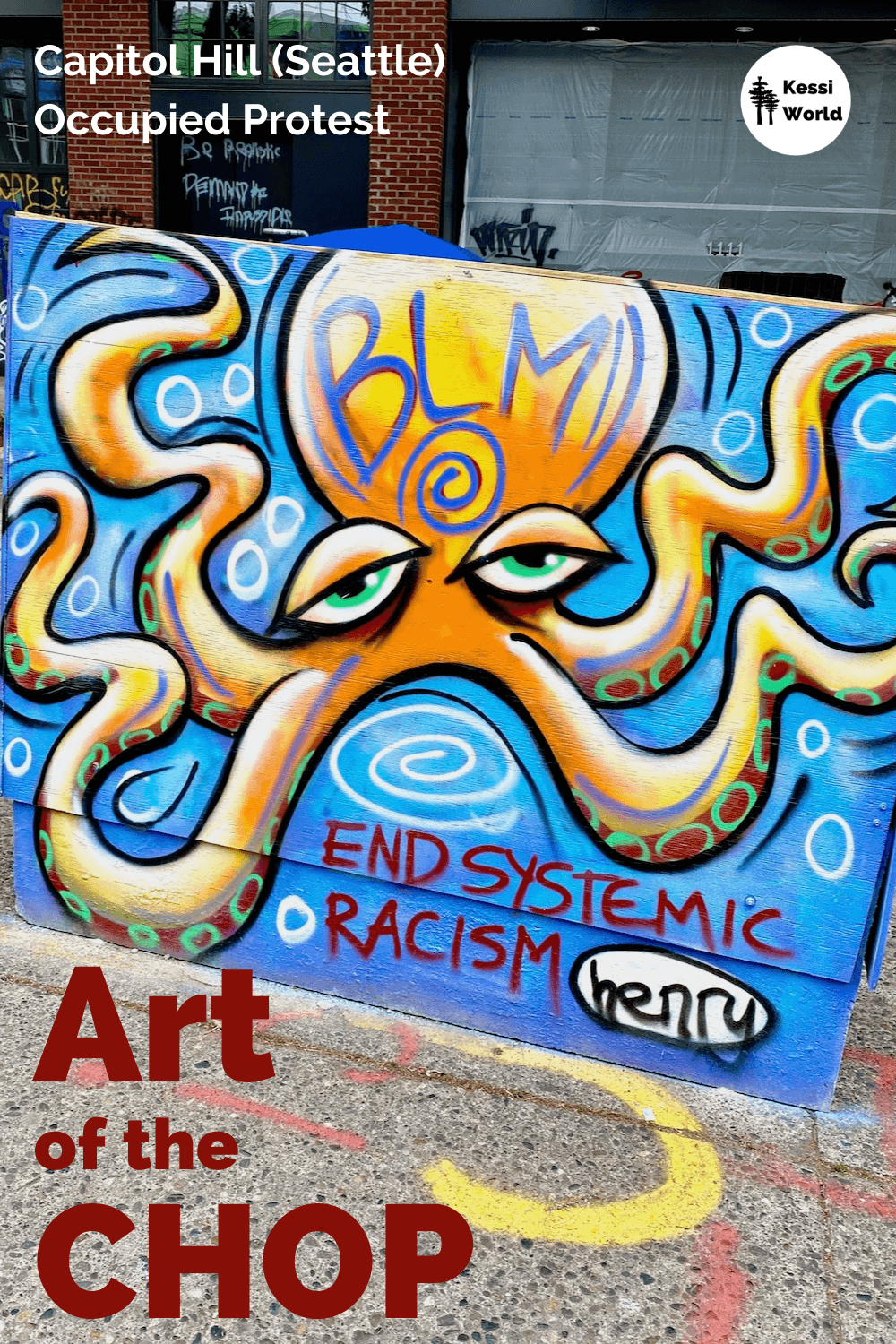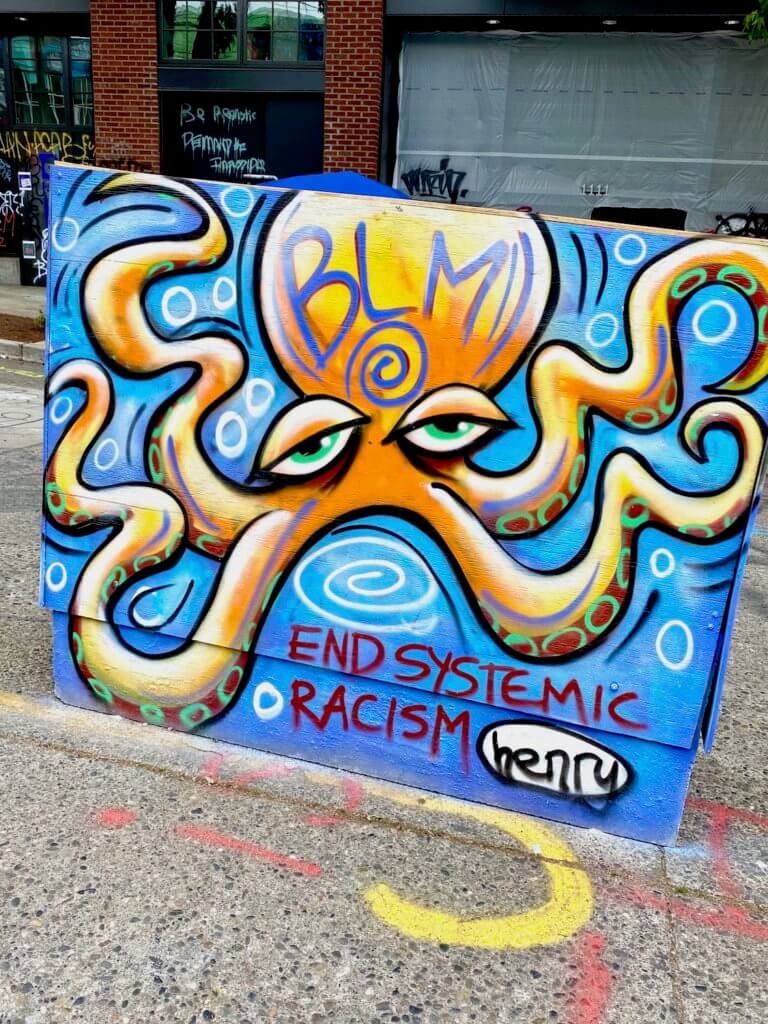
For the purposes of this article, I will refer to the area as CHOP, which existed for a few weeks in June, 2020. This area was initially known as CHAZ for Capitol Hill Autonomous Zone but eventually transitioned to CHOP.
Capitol Hill is my home.
The rolling hills of the Capitol Hill neighborhood in Seattle remain near and dear to my heart. Greenery abounds in every direction no matter the season, or rain or shine. 100 year old sidewalks bubble from the roots of old growth fir trees sandwiched in between overflowing gardens of flowers and steep streets of pavement, sometimes chipped away revealing the original bumpy gray cobblestones. Birds sing by day while bunnies hop around at night, bringing nature front and center to any living environment. Apartments, condos and single family homes nestle in together to form a community feeling that connects to the various stretches of commerce that include eateries, watering holes and mostly independent merchants working to bring their products to market.
But Capitol Hill is not just a pretty neighborhood — there is rich history steeped in the streets and avenues of independent business. This district, just a stone’s throw from downtown Seattle, embodies a history of art, activism, and diverse communities — including black and LGBTQ+. Over the past 10 years or so, rising interest in close-in city living increased housing demand, gentrifying the area in ways that pushed the black and LGBTQ communities to more affordable locales.
So it doesn’t surprise me that the protests following the grotesque video of George Flloyd’s murder at the hands of Minneapolis police inspired activism in support of the Black Lives Matter movement — establishing a “ground zero” of sorts around the East Police Precinct of Seattle.
Since the formation of CHOP a few weeks ago, I’ve visited a couple of times, always feeling a deep connection to the underlying message — end systemic white supremacy in the US. While many distractions exist that make it easy to fall back on the “yes, but did you see the……” (insert shootings or tent camps) the focus of the empowering feeling within my soul locks in on the energy around expression, anger, frustration and betrayal of the current societal structures in place that continue to “place a knee” on the necks of people of color — in particular black men and women.
It felt particularly raw for me to walk through Cal Anderson Park — a park that I routinely visited last summer with friends for outside movie nights on the lawn. Impromptu gardens were dug into the lawns in several places with newly planted flowers and vegetables with signs propped up speaking to various black innovations in farming and gardening. Although filming in this area was not allowed, one statistic that sticks in my mind is that in 1910 13% of the farmland in the United States was black owned while today that number is around 1%.
It’s important that you know I live in this area. The area that was CHOP was where I met friends for drinks at a local LGBTQ+ bar and ate sushi at a restaurant across the street from the boarded up police station. The traffic barriers placed in the street were covered with wall size plywood — painted in a way that reminds me of other famous walls and borders in the world. Read more about the comparison between Seattle’s CHOP and places like Berlin in a sister blog post, A Seattle Wall.
I’m sympathetic to the protests because many changes throughout American history only came after such actions were taken to sound the alarm to the people in control, historically white men, to important issues — like suffrage, ending the Vietnam War, civil rights and HIV/AIDS awareness. Saving, and improving, the lives of our fellow community members is essential to the fabric of this nation.
As I write this today, the Seattle police force is reclaiming the East Precinct Station and sweeping through Cal Anderson Park.
While the physical features might be removed, the spirit lives on and I hope this is only the start to meaningful changes in Seattle and the rest of the country. In my lifetime I want to take part in, and would love to witness, a tectonic shift away from white supremacy-based structures to an anti-racist world.
I created this site, Kessi World, to foster the quest for meaningful connections in the world, mostly through travel that can take many shapes and forms. So, it feels important to curate a collection of photos that grabbed my soul. A story of art pieces, now destroyed, created through the angst, tears, anger, fear and helplessness of my fellow citizens. Colors of paint on textures of wood, concrete and steel — all coming together in solidarity to empower… and say,
Black Lives Matter
Seattle’s wall — the art of CHOP
A line of concrete traffic dividers were framed with plywood in order to create the following art without destruction of property. This wall, of sorts extended along Pine Street between 11th and 12th Avenues in the Capitol Hill neighborhood of Seattle. The liquor store shown in the background of some of these photos is normally painted with commissioned murals.
East Precinct Police Station — Capitol Hill, Seattle
The East Precinct Station is at the intersection of Pine St. and 12th Avenue in the Capitol Hill neighborhood and served as ground zero for the more violent clashes between police and protesters in the weeks following the murder of George Flloyd. The police vacated the station in early June for cryptic reasons and CHOP developed around the boarded up building.
The neighborhood blocks surrounding CHOP in Seattle’s Capitol Hill
Neighborhood business, in general, supports the protest and most buildings were already boarded up due to the abrupt Covid-19 closing requirement in March, 2020.

